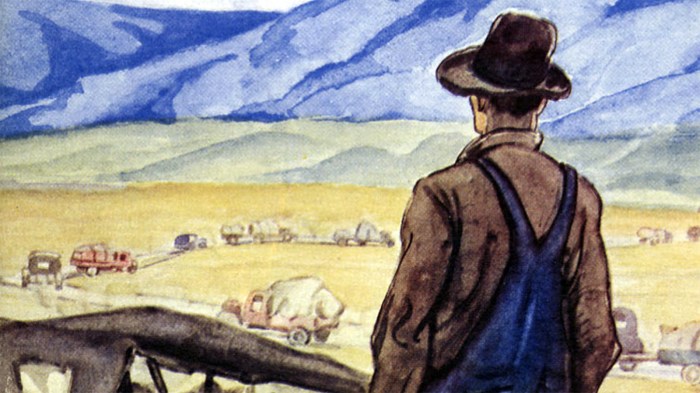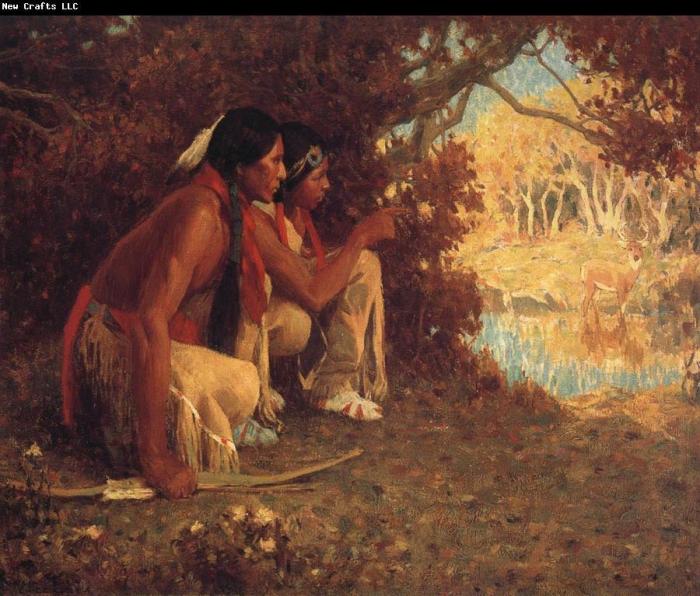Chapter 10 grapes of wrath – In Chapter 10 of John Steinbeck’s classic novel, The Grapes of Wrath, the Joad family’s journey continues as they face new challenges and encounter characters who shape their destiny. This chapter offers a powerful exploration of the themes of hope, despair, and the human spirit in the face of adversity.
As the Joads travel west, they encounter a variety of obstacles, including discrimination, poverty, and exploitation. However, they also find moments of compassion and kindness that sustain them on their journey.
Historical Context
The Grapes of Wrath was written during the Great Depression, a period of economic crisis that began in 1929 and lasted throughout the 1930s. The Depression had a devastating impact on the American people, leading to widespread unemployment, poverty, and homelessness.
In Chapter 10 of “Grapes of Wrath,” Steinbeck paints a vivid picture of the Joads’ struggle against eviction. Legal cases like Cromwell v. County of Sac provide real-life examples of the injustices faced by farmers during this period. The chapter underscores the importance of standing up for one’s rights, a theme that resonates throughout “Grapes of Wrath.”
One of the most severe consequences of the Great Depression was the Dust Bowl, a series of severe dust storms that ravaged the southern Great Plains from 1930 to 1936. The Dust Bowl caused widespread crop failures and forced millions of farmers to abandon their land and migrate westward in search of work.
The Dust Bowl
- The Dust Bowl was caused by a combination of factors, including drought, overgrazing, and poor farming practices.
- The storms stripped away the topsoil, leaving the land barren and unable to support crops.
- The Dust Bowl forced millions of farmers to abandon their land and migrate westward in search of work.
Migration Westward
- The westward migration of farmers during the Dust Bowl had a profound impact on the American West.
- The migrants competed with local workers for jobs, driving down wages and creating social tensions.
- The migrants also brought with them their own culture and values, which influenced the development of the West.
Character Development
John Steinbeck’s The Grapes of Wrathfeatures a cast of unforgettable characters who undergo significant development throughout the novel. Among them, Tom Joad and Ma Joad stand out as central figures whose transformations shape the story’s trajectory.
Tom Joad
Initially portrayed as a restless and rebellious young man, Tom Joad emerges as a complex and compassionate protagonist. After serving time in prison for manslaughter, he returns home to find his family facing eviction from their farm. Witnessing the injustice and poverty endured by migrant workers, Tom becomes increasingly radicalized.
His experiences on the road and his interactions with other characters, such as Jim Casy and Casey, lead him to embrace a more collectivist worldview and a commitment to social justice.
Ma Joad
Ma Joad serves as the matriarch and moral compass of the family. A strong and resilient woman, she holds the Joads together through adversity and provides unwavering support to her children. Ma Joad’s wisdom and unwavering belief in the importance of family and community guide the Joads through their darkest moments.
Her unwavering determination and resilience in the face of adversity make her a symbol of strength and hope.
Relationships within the Joad Family
The relationships between the Joad family members evolve significantly throughout the novel. Initially, the family is close-knit and supportive, but the hardships they face on the road put their bonds to the test. As they travel together, they confront their own strengths and weaknesses and learn to rely on one another in new ways.
The relationships between Tom and his mother, Ma Joad, and between Tom and his brother, Al, undergo particularly significant transformations.
Themes and Symbolism
Chapter 10 of “The Grapes of Wrath” delves into profound themes of hope, despair, and the resilience of the human spirit amidst adversity. The imagery of grapes serves as a potent symbol that encapsulates these themes.
The Grapes as a Symbol of Hope
The grapes represent the dreams and aspirations of the Joad family. They symbolize the promise of a better life, a future free from poverty and oppression. The sight of the grapes fills the Joads with a sense of hope, reminding them of the possibility of a better tomorrow.
The Grapes as a Symbol of Despair
However, the grapes also become a symbol of despair. As the Joads struggle to survive in the harsh conditions of the camp, the grapes begin to rot and decay. This decay mirrors the fading hopes and dreams of the Joads, as their situation worsens and their future becomes increasingly uncertain.
Biblical Allusions and Their Significance
The novel employs biblical allusions to convey its message about the plight of the poor and oppressed. The imagery of the grapes recalls the biblical story of the Israelites wandering in the desert, where they longed for the promised land of Canaan.
This allusion suggests that the Joads’ journey is a modern-day exodus, a struggle for a better life in the face of adversity.
Narrative Structure and Style
Chapter 10 of The Grapes of Wrathis a masterpiece of narrative structure and style. Steinbeck employs a complex interplay of flashbacks and foreshadowing to create a rich and immersive reading experience.
Use of Flashbacks
Steinbeck frequently uses flashbacks to provide insights into the Joad family’s past and motivations. These flashbacks serve several purposes: they establish the family’s deep connection to the land, highlight the economic pressures that drove them from their home, and foreshadow the challenges they will face in California.
Foreshadowing
Steinbeck also employs foreshadowing to hint at the tragic events that lie ahead for the Joads. For example, the description of the “hungry men” who gather in the town square foreshadows the violence and unrest that will erupt later in the novel.
Writing Style
Steinbeck’s writing style in Chapter 10 is characterized by its simplicity, lyricism, and emotional depth. He uses short, declarative sentences to convey the harsh realities of the Joads’ situation, while his use of vivid imagery and poetic language creates a powerful emotional resonance.
Figurative Language
Steinbeck’s use of figurative language enhances the emotional depth of the chapter. Similes and metaphors, such as comparing the Joads’ journey to a “flight of locusts” and describing the land as a “starved mother,” create vivid and memorable images that convey the family’s desperation and suffering.
Social Commentary

Chapter 10 of “The Grapes of Wrath” is a powerful indictment of the economic and social injustices of the time. Steinbeck’s unflinching portrayal of the struggles faced by the Joad family highlights the plight of marginalized communities during the Great Depression.
Exploitation of Migrant Workers
The novel exposes the harsh realities of migrant labor. The Joads are forced to work for poverty wages, and they are constantly exploited by unscrupulous employers. Steinbeck shows how the system is rigged against the poor, and he exposes the dehumanizing conditions that migrant workers endure.
Government Indifference
Steinbeck also criticizes the government’s indifference to the plight of the poor. The Joads encounter little help from government agencies, and they are left to fend for themselves. Steinbeck shows how the government has failed to protect its citizens, and he highlights the need for social reform.
The Importance of Community
Despite the hardships they face, the Joads find strength in their community. They help each other through difficult times, and they provide a sense of belonging. Steinbeck shows how community can help people overcome adversity, and he emphasizes the importance of social bonds.
Symbolism and Imagery

The symbolism and imagery in Chapter 10 of The Grapes of Wrath enhance the novel’s themes and character development. The turtle, a recurring symbol throughout the novel, represents resilience and determination in the face of adversity. The “turtle race” signifies the Joad family’s arduous journey and their struggle to survive amidst overwhelming challenges.
Imagery of the Land and Crops
The imagery of the land and crops reflects the characters’ connection to nature. The land provides sustenance and a sense of belonging, but it can also be unforgiving and destructive. The crops represent the family’s hopes and dreams, but they are vulnerable to drought and exploitation.
Through these vivid descriptions, Steinbeck conveys the interconnectedness of the Joads and their environment.
Characterization and Dialogue

John Steinbeck’s The Grapes of Wrathfeatures a rich cast of characters whose struggles and interactions shape the narrative. Among them, the preacher Jim Casy and the Joad family members stand out for their compelling characterizations and the significance of their dialogues.
Casy as a Spiritual Guide
Jim Casy is a former preacher who has lost his faith but continues to seek spiritual meaning in life. His interactions with the Joads reveal his compassion, wisdom, and resilience. Casy’s speeches and sermons provide moments of reflection and guidance for the characters and readers alike.
Dialogue and Inner Conflict
The dialogue in The Grapes of Wrathis authentic and insightful. The characters’ conversations often expose their inner conflicts and motivations. For instance, the Joads’ discussions about leaving their home and the future reveal their fears, hopes, and the complexities of their relationships.
Use of Dialect
Steinbeck’s use of dialect in the characters’ speech contributes to the authenticity of their voices. The Joads’ Oklahoma dialect, with its unique vocabulary and pronunciation, adds depth and realism to their characters. This dialectal richness enhances the reader’s understanding of the characters’ backgrounds and cultural context.
Literary Devices
In Chapter 10 of The Grapes of Wrath, Steinbeck masterfully employs literary devices to enhance the reader’s understanding of the characters and their arduous journey.
Foreshadowing and Irony
Steinbeck skillfully uses foreshadowing to hint at future events and create a sense of impending doom. For instance, the mention of the “black dust” in the opening pages foreshadows the suffocating dust storms that will plague the Joad family later in the novel.
Similarly, the description of the “dead land” foreshadows the desolate and barren conditions the Joads will encounter on their journey.
Irony is another literary device that Steinbeck employs to create a sense of contrast and highlight the characters’ struggles. For example, the Joads’ hopes for a better life in California are ironically contrasted with the harsh realities they face upon arrival.
The family’s desire for land is met with the stark reality of their status as migrant workers, subject to exploitation and poverty.
Similes and Metaphors
Steinbeck’s use of similes and metaphors adds depth and emotional resonance to the narrative. Similes, such as comparing the Joads’ car to “a broken-winged bird,” create vivid images that help the reader visualize the family’s struggles. Metaphors, such as describing the land as “a dead thing,” convey the emotional impact of the Joads’ journey and the sense of loss and displacement they experience.
Historical Context
The Great Depression devastated the American economy, leading to widespread unemployment and poverty. The labor movement, which had been growing in strength in the early 20th century, became increasingly important as workers sought to protect their rights and improve their working conditions.
Migrant workers were particularly hard-hit by the Depression. They often worked in low-paying, dangerous jobs and lived in squalid conditions. The Joad family’s experiences in The Grapes of Wrathreflect the broader struggles of the working class during this time.
The Labor Movement
- The labor movement fought for better wages, working conditions, and benefits for workers.
- The American Federation of Labor (AFL) and the Congress of Industrial Organizations (CIO) were two of the most important labor unions during this time.
- The labor movement helped to improve the lives of millions of workers, but it also faced significant opposition from employers and the government.
Conditions Faced by Migrant Workers
- Migrant workers often worked long hours for low pay.
- They lived in crowded and unsanitary conditions.
- They were often subjected to discrimination and violence.
The Joad Family’s Experiences
- The Joad family is forced to leave their home in Oklahoma after losing their farm to foreclosure.
- They travel to California in search of work, but they face discrimination and exploitation.
- The Joad family’s experiences highlight the challenges faced by migrant workers during the Great Depression.
Character Development
In Chapter 10, Tom Joad undergoes significant growth and transformation. His experiences in the Hoovervilles and the labor camps profoundly shape his political and social views.
Tom’s Political and Social Awakening, Chapter 10 grapes of wrath
Tom’s experiences with poverty, hunger, and exploitation awaken him to the systemic injustices faced by the working class. He witnesses firsthand the brutality of the police and the indifference of the authorities. These experiences radicalize him, leading him to embrace a more militant and revolutionary stance.
Tom’s Journey as a Reflection of Broader Themes
Tom’s journey mirrors the broader themes of the novel. His transformation from a naive and idealistic young man into a hardened and disillusioned activist reflects the collective experience of the Okies during the Great Depression. It highlights the corrosive effects of poverty and the dehumanizing impact of social inequality.
FAQ Overview: Chapter 10 Grapes Of Wrath
What is the significance of the turtle in Chapter 10?
The turtle symbolizes the Joads’ slow and arduous journey westward. It also represents the resilience and determination of the human spirit in the face of adversity.
How does Tom Joad change throughout Chapter 10?
Tom Joad becomes increasingly radicalized as he witnesses the injustices faced by migrant workers. He begins to question the existing social order and becomes more determined to fight for the rights of the working class.
What is the role of Casy in Chapter 10?
Casy serves as a spiritual guide for the Joads. He provides them with hope and inspiration, and helps them to find meaning in their suffering.